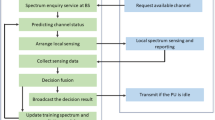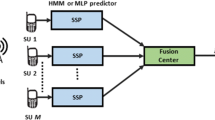Abstract
Combining spectrum sensing (SS) and primary user (PU) traffic forecasting provides a cognitive radio network with a platform from which informed and proactive operational decisions can be made. The success of these decisions is largely dependent on prediction accuracy. Allowing secondary users (SU) to perform these predictions in a collaborative manner allows for an improvement in the accuracy of this process, since individual SUs may suffer from SS and prediction inaccuracies due to poor channel conditions. To overcome these problems a collaborative approach to forecasting PU traffic behaviour, that combines SS and forecasting through SU cooperation, has been proposed in this article. Both pre-fusion and post-fusion scenarios for cooperative prediction were investigated and a number of binary prediction methods were considered (including the authors’ own simple technique). Cooperative prediction performance was investigated, under various PU traffic conditions, for a group of ten SUs experiencing different channel conditions and a sub-optimal cooperative forecasting algorithm was proposed to minimise cooperative prediction error. Simulation results indicated that the accuracy of the prediction methods was influenced by the PU traffic pattern and that cooperative prediction lead to a significant improvement in prediction accuracy under most of the traffic conditions considered. However, this came at the cost of increased computational complexity. The pre-fusion scenario was found to be the most accurate scenario (up to 25 % improvement), but was also eleven times more complex than when no fusion was employed. The cooperative forecasting algorithm was found to further improve these results.














Similar content being viewed by others
References
Adas, A. M. (1998). Using adaptive linear prediction to support real-time VBR video under RCBR network service model. IEEE/ACM Transactions on Network, 6(5), 635–644.
Akyildiz, I. F., Lo, B. F., & Balakrishnan, R. (2011). Cooperative spectrum sensing in cognitive radio networks: A survey. Physical Communications, 4(1), 40–62.
Arshad, A., & Hassan, S. A. (2015). Maximum likelihood SNR estimation for non-coherent FSK-based cooperative networks over correlated Rayleigh fading channels. In Proceedings of IEEE wireless communication network conference (pp. 636–641). New Orleans, United States.
Atapattu, S., Tellambura, C., & Jiang, H. (2011). Energy detection based cooperative spectrum sensing in cognitive radio networks. IEEE Transaction on Wireless Communications, 10(4), 1232–1241.
Barnes, S. D., Jansen van Vuuren, P. A., & Maharaj, B. T. (2013). Spectrum occupancy investigation: Measurements in South Africa. Measurement, 46(9), 3098–3112.
Barnes, S. D., & Maharaj, B. T. (2011). Performance of a hidden Markov channel occupancy model for cognitive radio. In Proceedings of IEEE AFRICON conference (pp. 1–6). Livingstone, Zambia.
Barnes, S. D., & Maharaj, B. T. (2013). An occupancy window approach to primary user traffic modelling for cognitive radio. In: Proceedings of SATNAC (pp. 395–399). Stellenbosch, South Africa.
Barnes, S. D., & Maharaj, B. T. (2014). Prediction based channel allocation performance for cognitive radio. AEU-International Journal of Electronics and Communications, 68(4), 336–345.
Barnes, S. D., & Maharaj, B. T. (2015). Collaborative spectral opportunity forecasting for cognitive radio. In Proceedings of IEEE AFRICON conference (pp. 1–6). Addis Ababa, Ethiopia.
Chen, Z., Guo, N., Hu, Z., & Qiu, R. C. (2011). Experimental validation of channel state prediction considering delays in practical cognitive radio. IEEE Transactions on Vehicular Technology, 60(4), 1314–1325.
Deng, R., Chen, J., Yuen, C., Cheng, P., & Sun, Y. (2012). Energy-efficient cooperative spectrum sensing by optimal scheduling in sensor-aided cognitive radio networks. IEEE Transactions on Vehicular Technology, 61(12), 716–725.
Ghasemi, A., & Sousa, E. (2007). Opportunistic spectrum access in fading channels through collaborative sensing. Journal of Communications, 2(2), 71–82.
Ghosh, C., Cordeiro, C., Agrawal, D. P., & Rao, M. B. (2009). Markov chain existence and hidden markov models in spectrum sensing. In Proceedings of 7th annuval IEEE international conference on pervasive computer communications (pp. 1–6). Galveston, TX.
Ghosh, C., Pagadarai, S., Agrawal, D. P., & Wyglinski, A. M. (2010). A framework for statistical wireless spectrum occupancy modeling. IEEE Transaction on Wireless Communications, 9(1), 38–44.
Hassan, S. A., & Ingram, M. A. (2012). Pilot assisted SNR estimation in a non-coherent M-FSK receiver with a carrier frequency offset. In Proceedilngs of IEEE international conference on communications (pp. 3698–3702). Ottawa, Canada.
Haykin, S. (2005). Cognitive radio: Brain-empowered wireless communications. IEEE Journal on Selected Areas in Communications, 23(2), 201–220.
Höyhtyä, M., Pollin, S., & Mämmelä, A. (2008). Performance improvement with predictive channel selection for cognitive radios. In Proceedings of 1st international workshop cognitive radio advanced spectrum management (pp. 1–5). Aalborg, Denmark.
Kulkarni, P., Lewis, T., & Fan, Z. (2011). Simple traffic prediction mechanism and its applications in wireless networks. Wireless Personal Communications, 59(2), 261–274.
Kuo, W. K., & Lien, S. Y. (2009). Dynamic resource allocation for supporting real-time multimedia applications in IEEE 802.15.3 WPANs. IET Communications, 3(1), 1–9.
Mitola, J, I. I. I., & Maguire, G. Q, Jr. (1999). Cognitive radio: Making software radios more personal. IEEE Personal Communication, 6(4), 13–18.
Savaux, V., Louët, Y., Djoko-Kouam, M., & Skrzypczak, A. (2013). Application of a joint and iterative MMSE-based estimation of SNR and frequency-selective channel for OFDM systems. Eurasip Journal of Advances Signal Processing, 1(128), 1–11.
Unnikrishnan, J., & Veeravalli, V. (2008). Cooperative sensing for primary detection in cognitive radio. IEEE Journal of Selected Topics in Signal Processing, 2(1), 18–27.
Urkowitz, H. (1967). Energy detection of unknown deterministic signals. Proceedings of the IEEE, 55(4), 523–531.
Wen, Z., Fan, C., Zhang, X., Wu, Y., Zou, J., & Liu, J. (2010). A learning spectrum hole prediction model for cognitive radio systems. In Proceedings of 10th IEEE international conference on computer and information technology (pp. 2089–2093). Bradford, UK.
Yang, C. S., Chuang, L. Y., Chen, Y. J., & Yang, C. H. (2008). Feature selection using memetic algorithms. In Proceedings of international conference on convergence hybrid information technology (pp. 416–423). Busan, South Korea.
Yao, Y., Feng, Z., Li, W., & Qian, Y. (2010). Dynamic spectrum access with QoS guarantee for wireless networks: A Markov approach. In Proceedings of IEEE global telecommunication conference (pp. 1–5). Miami, FL.
Yarkan, S., & Arslan, H. (2007). Binary time series approach to spectrum prediction for cognitive radio. In Proceedings of IEEE vehicular technololgy conference (pp. 1563–1567). Baltimore, MD.
Yücek, T., & Arslan, H. (2009). A survey of spectrum sensing algorithms for cognitive radio applications. IEEE Communications Surveys and Tutorials, 11(1), 116–130.
Acknowledgments
This research was supported by the Sentech Chair in Broadband Wireless Multimedia Communication (BWMC), the National Research Foundation (NRF) and the Independent Communications Authority of South Africa (ICASA).
Author information
Authors and Affiliations
Corresponding author
Appendix
Appendix
In this appendix the expression for \(\lambda _{i}\) is derived.
Lemma 1
The signal detection threshold \(\lambda _{i}\) is given by the following expression,
where \(\mu _{s}\) and \(\sigma ^2_{s}\) are the mean and variance of the information carrying component of a received signal respectively and \(\sigma ^2_{n}\) is the variance of the noise component.
Proof
Let the probability density functions of the information and noise components be,
and
respectively.
To solve for x, let \(\rho _{n}(x)=\rho _{s}(x)\) such that,
This expression can be simplified and written in the form of a second order polynomial, \(ax^2 + bx + c = 0\), where the coefficient are given as,
If \(\lambda _{i}=x\), is the solution for Eq. (36), then,
But, under the assumption that \(\rho _{n} = \mathcal {N}\left( 0,\sigma ^2_{n} \right)\), \(\mu _{n}=0\) must be substituted into Eq. (40) to give the following expression,
If it is assumed that \(\mu _{s} > 0\), then it follows that,
Therefore, since \(\lambda _{i} \le \mu _{s}\), Eq. (41) becomes,
\(\square\)
Rights and permissions
About this article
Cite this article
Barnes, S.D., Maharaj, B.T. & Alfa, A.S. Cooperative Prediction for Cognitive Radio Networks. Wireless Pers Commun 89, 1177–1202 (2016). https://doi.org/10.1007/s11277-016-3311-z
Published:
Issue Date:
DOI: https://doi.org/10.1007/s11277-016-3311-z




